AS IF IT WERE AN ISLAND, a serious adventure AIWAII page
Polynesians searched for islands in sailing canoes, but their achievement rested as much on feeding themselves as on sailing, as much on paddling all day if needed as on their famous navigation.
California was thought to be an island by the first Western explorers, coming from the south and seeing Baja. The island of Califia.
Adventuring literature says one thing clearly: it’s mostly about the people you meet on the way.
What if we weave these 3 threads into one great race? To circumnavigate northern California, by fair means, and talk to the inhabitants and take them sailing.
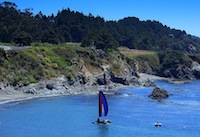
This picture has some of the elements: a bit of road, difficult access, shorepeople, one of them learning to sail in a place worth exploring.
Fair means, to me, is:
~ Gain the strength to do the race gracefully and without depending on others when something goes amiss.
~ Participate in the design and building of the boat.
~ Grow and preserve a meaningful portion of the food.
~ Put the carbon back in the ground.
To do less than these four things is to rely on others for essential power, like winning a footrace piggyback.
As a migrant from the midwest in the 60’s I really fell for northern California’s geography and history. It seems enough for many lifetimes and I can’t see bothering with the rest of the world till then. Wouldn’t it be something if just by refocusing, one could see it is an island that can be sailed around?
To me it just hangs there now, perfectly ripe for the picking. Sixteen hundred miles of virgin coast (in a manner of speaking!), a three month voyage of discovery, and that’s the easy part. Boatbuilding is harder than sailing,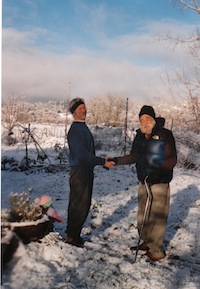 and provisioning is harder than both. The no-net-CO2 is easy by comparison.
and provisioning is harder than both. The no-net-CO2 is easy by comparison.
Why am I talking about this rather than doing it? I am doing it, just taking quite a bit longer to prepare than one would have thought. The boat part is very tricky and the food part is daunting. What has really kept me near home though was my father, quite disabled and in my care 24/7. But now he’s suddenly gone. I was having fun dreaming about freedom but it’s not what I really wanted. I was very happy taking care of him to the very last. Over the years, Alzheimer’s took away all that was hard and bitter in the old Cold War warrior and left just the sweetest guy, smiling (with effort) on his last day.
So I hope you are curious by now about how does one sail ’As If It Were An Island?” My plan is for a voyage that would FEEL very much like a circumnavigation, though supported by car. The voyageur would actually sail (and paddle and run and swim) the full 1600 mile distance around the northern half of California, turning corners in Monterey Bay and Death Valley, in the lava of Modoc and the redwoods of the Smith.
The idea is found in an atlas, like the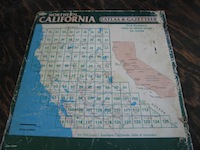 DeLorme “Northern California Atlas and Gazetteer.”
The maps make for good daydreams but the clincher is the grid on the back cover,
the key to the page numbers of the maps within, 125 of them. The wandering mind notices
there is a path, 44 steps long, all the way around, each little square representing about
a thousand square miles of quite various terrain. Water of every description!
DeLorme “Northern California Atlas and Gazetteer.”
The maps make for good daydreams but the clincher is the grid on the back cover,
the key to the page numbers of the maps within, 125 of them. The wandering mind notices
there is a path, 44 steps long, all the way around, each little square representing about
a thousand square miles of quite various terrain. Water of every description!
One would arrive in a square by car and sail a distance equivalent to crossing it, about 40 miles. This would usually take two days and two bodies of water. From there a short cartopping trip to the next square, just an hour every 2 or 3 days, no more than most sailors run their engines. It would add up to about a hundred lakes, estuaries, the ocean on nice days, mirages, marshes, and wide pools in rivers.
Having recently tried to follow this course on Google Earth, I must emphatically recommend the paper atlas. Thin and seasonal water doesn’t show well in the photographs. It made me doubt what I believe to be true: there IS enough water to sail around California! All that’s lacking is vision.
It wouldn’t really matter if the voyageur had to log 20 miles on a farm pond, stopping to talk to the animals, if that was the only choice. A pond has the same wind, the same stars, the same view of the mountains you’ll be in tomorrow as the best sailing venue. Put that farm pond day among 90 other diverse days and it would feel like an essential and memorable step on the way.
If one sailed this course it might be a good story, but maybe the times are right for a great one. This place is geographically
splendid and its people are great, too. They need reminded.
but maybe the times are right for a great one. This place is geographically
splendid and its people are great, too. They need reminded.
If the course were not only around the state but through the territory of shorepeople, if the challenge was not just wind and wave but character, if the boat was fascinating and quickly seen as appropriate, there would be a lot people who came sailing for a short time, as various as the terrain.
If one sailed this course powered by big-box-store food one might get there, but where is there? The energy is coming from someone else and one only imagines that it is one’s own. Growing and preserving food is such a challenge that every Polynesian voyager must have been directly involved, no one was too important. Digging and paddling use the same muscles. After gardening an acre with a shovel the state seems less intimidating. Sitting in a boat you built stowed with food you produced, you’d spend less time wondering “Who am I and what the heck am I doing?” At least that’s the theory.
If one sailed this course, were friendly as the day is long and ate only homegrown bread, but spent more carbon than one earned, it would be a missed opportunity. It is not a big deal to put the carbon back in the ground, just a small fraction of the effort that goes into the food, a small detail that our society in its “Toad of Toad Hall” exuberance is leaving out.
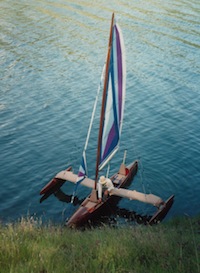
If one sailed this course and was not in the best shape of one’s life, one would have to have missed something.
As mentioned in “History” I have sailed about 400 miles at Lake M developing the AIIWAI “rules”. I submit them to your scrutiny only in the spirit of “what the heck, why not?”
~Stone’s throw from shore.
An imaginary stone, but can be tested when necessary. Everything needed in a challenging course: constantly changing scenery and exposure, always something coming just around a corner, both physical and mental demands, and the natives.
~Running or walking counts for up to 20% of the distance.
The ease of landing makes this the natural thing. But running is faster than
sailing alongshore, and this is a sailing voyage, so 20% is enough. Except maybe in the desert, who knows? It’s about style and stories.
~Swimming measured by time. Swimming is slow but important and needs a subsidy. So time spent swimming is time spent at average daily speed.
~Portaging counts too, at 6X the distance, so from cartop to sailready is paid-for time.
~Last and most important, a shoreperson who comes for a ride, long enough for a real exchange of thoughts, adds 5% to the day’s total. One who actually sails, sitting in the stern seat and feeling the magic between wind and wave, counts 10%.
I averaged a little over one person per day riding and one every four days who learned to sail, sort of.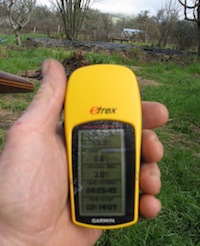 Five and ten percent may seem like a lot, but it takes
time and is at the heart of the matter. We’ll be fishers of men!
Five and ten percent may seem like a lot, but it takes
time and is at the heart of the matter. We’ll be fishers of men!
GPS makes it flow, it’s easy to keep track. I like the way every bit of effort, from portaging the boat to running to the bathroom, is counted (unless the batteries die). The inshore course means way more tacking but you get paid for the trouble, since all the zig-zags count. AIWAII is about the shoreline, not just getting around or across, so it’s good that all the distance in and out of some interesting cove is measured automatically.
Whether eating one’s own food, building one’’s own boat, and paying the carbon tax are really at the heart of the idea, I don’t know.
They are what I do.
the carbon tax are really at the heart of the idea, I don’t know.
They are what I do.
I hope to tell the story of many such voyages by many people, each a chapter. I hope that California can benefit.
This may all sound highly improbable. There are a few factors that might help it happen:
~There is quite a history of unlikely human-powered voyages, it’s in the genes. There’s the guy who climbed Everest alone, after biking there alone from his home in Denmark. That’s real style.
~AIIWAI is not an epic, it’s just a great tour, supported by a car carrying unlimited amenities, if bears don’t eat them. I see the voyager sleeping and eating mostly on the small trimaran, though, so the bears may overlook him.
~This is not about grinding out the distance. It is style, every minute, to always be playing with or about to play with the wind, to sail the difficult inshore path, and to be ready for whoever. A canoe tri is quite a bit more boat than one would need just to get around; it is not faster to sail/paddle this course than to paddle, it is better.
~With my father gone, after seven years with no more than a few hours off, I’m suddenly overcome by freedom, and certainly can’t escape doing AIIWAI after talking about it.
~Every day I’ve ever spent doing this has made me want to just do the same, the next.
Perhaps the AIIWAI idea can be applied to any geography, like a county, and so be more practical and shine a new light on that county. I can now see going around Mendocino in 8 days, about 255 miles, on two reservoirs, a wide spot on a river in a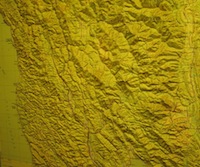 deep canyon, a small natural lake in a perfect setting, two estuaries, and two
small ocean bays. And last the south coast below Point Arena
where the shoreline heads east, giving more protection, maybe
a single long leg downwind and a hitchhike back.
deep canyon, a small natural lake in a perfect setting, two estuaries, and two
small ocean bays. And last the south coast below Point Arena
where the shoreline heads east, giving more protection, maybe
a single long leg downwind and a hitchhike back.
Over 30 miles a day may be sustainable for a week, maybe not.
Perhaps no one will be surprised to learn that though we’ve talked a lot about about boating, gardening, and strength, and have been in business for 35 years, we know not a lot about making a living at it. We know how to find $20 an hour jobs of every description and get by, and how to lose money, year after year, on Canoetri development. We love meeting people and the challenge of managing a small adventure safely without being boring. But the details of sustainably extracting a buck from this process are obscure at this time.
We have plenty of work that needs done, and have to keep making that $20, but what we really want is to redeem a lifetime’s investment in the canoe trimaran by making a living at it. Building new redwood boats on speculation would be a mistake in an economy where the only people with money don’t buy, they fly to “paradise” and rent. They are far from the AIWAII idea of self-reliance and finding the true beauty of home. I don’t want to spend 450 hours building a tri in the hope that someone would buy it for mere money and stash it in his summer home.
What I want is to build it WITH a real person to whom all parts of the AIIWAI idea appeal equally, someone who can see the heart of a real adventure, someone with just the slightest built-in contempt for jet-based culture. But, who’s got 10 weeks to complete their own boat, (and that would be with us doing half the work)? It wouldn’t be like modern times.
Perhaps there are some who would like to spend a few days in this valley, just touching on the idea, helping work on a boat in progress, gardening and preserving, sailing our boats. It’s a beautiful place to exercise.
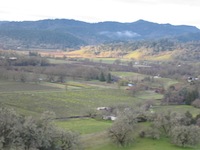
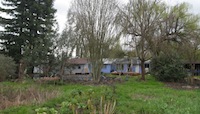 Think of it as an apprenticeship in building any graceful shape from a durable, good-looking material.
Think of it as an apprenticeship in building any graceful shape from a durable, good-looking material.
I’m not ready for AIIWAI around California, but we’ll see. It would be good to look upon the face of someone who thinks he or she can not only do this, but sooner or better than me.
For the rest of you, thanks for reading. You are welcome to any of the ideas and designs presented on this website, to make them your own as you see fit. If you undertake them in your own neighborhood I will support you any way I can.
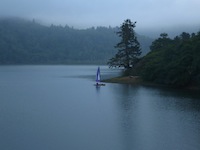
Polynesians searched for islands in sailing canoes, but their achievement rested as much on feeding themselves as on sailing, as much on paddling all day if needed as on their famous navigation.
California was thought to be an island by the first Western explorers, coming from the south and seeing Baja. The island of Califia.
Adventuring literature says one thing clearly: it’s mostly about the people you meet on the way.
What if we weave these 3 threads into one great race? To circumnavigate northern California, by fair means, and talk to the inhabitants and take them sailing.

This picture has some of the elements: a bit of road, difficult access, shorepeople, one of them learning to sail in a place worth exploring.
Fair means, to me, is:
~ Gain the strength to do the race gracefully and without depending on others when something goes amiss.
~ Participate in the design and building of the boat.
~ Grow and preserve a meaningful portion of the food.
~ Put the carbon back in the ground.
To do less than these four things is to rely on others for essential power, like winning a footrace piggyback.
As a migrant from the midwest in the 60’s I really fell for northern California’s geography and history. It seems enough for many lifetimes and I can’t see bothering with the rest of the world till then. Wouldn’t it be something if just by refocusing, one could see it is an island that can be sailed around?
To me it just hangs there now, perfectly ripe for the picking. Sixteen hundred miles of virgin coast (in a manner of speaking!), a three month voyage of discovery, and that’s the easy part. Boatbuilding is harder than sailing,
 and provisioning is harder than both. The no-net-CO2 is easy by comparison.
and provisioning is harder than both. The no-net-CO2 is easy by comparison.
Why am I talking about this rather than doing it? I am doing it, just taking quite a bit longer to prepare than one would have thought. The boat part is very tricky and the food part is daunting. What has really kept me near home though was my father, quite disabled and in my care 24/7. But now he’s suddenly gone. I was having fun dreaming about freedom but it’s not what I really wanted. I was very happy taking care of him to the very last. Over the years, Alzheimer’s took away all that was hard and bitter in the old Cold War warrior and left just the sweetest guy, smiling (with effort) on his last day.
So I hope you are curious by now about how does one sail ’As If It Were An Island?” My plan is for a voyage that would FEEL very much like a circumnavigation, though supported by car. The voyageur would actually sail (and paddle and run and swim) the full 1600 mile distance around the northern half of California, turning corners in Monterey Bay and Death Valley, in the lava of Modoc and the redwoods of the Smith.
The idea is found in an atlas, like the
 DeLorme “Northern California Atlas and Gazetteer.”
The maps make for good daydreams but the clincher is the grid on the back cover,
the key to the page numbers of the maps within, 125 of them. The wandering mind notices
there is a path, 44 steps long, all the way around, each little square representing about
a thousand square miles of quite various terrain. Water of every description!
DeLorme “Northern California Atlas and Gazetteer.”
The maps make for good daydreams but the clincher is the grid on the back cover,
the key to the page numbers of the maps within, 125 of them. The wandering mind notices
there is a path, 44 steps long, all the way around, each little square representing about
a thousand square miles of quite various terrain. Water of every description!
One would arrive in a square by car and sail a distance equivalent to crossing it, about 40 miles. This would usually take two days and two bodies of water. From there a short cartopping trip to the next square, just an hour every 2 or 3 days, no more than most sailors run their engines. It would add up to about a hundred lakes, estuaries, the ocean on nice days, mirages, marshes, and wide pools in rivers.
Having recently tried to follow this course on Google Earth, I must emphatically recommend the paper atlas. Thin and seasonal water doesn’t show well in the photographs. It made me doubt what I believe to be true: there IS enough water to sail around California! All that’s lacking is vision.
It wouldn’t really matter if the voyageur had to log 20 miles on a farm pond, stopping to talk to the animals, if that was the only choice. A pond has the same wind, the same stars, the same view of the mountains you’ll be in tomorrow as the best sailing venue. Put that farm pond day among 90 other diverse days and it would feel like an essential and memorable step on the way.
If one sailed this course it might be a good story,
 but maybe the times are right for a great one. This place is geographically
splendid and its people are great, too. They need reminded.
but maybe the times are right for a great one. This place is geographically
splendid and its people are great, too. They need reminded.
If the course were not only around the state but through the territory of shorepeople, if the challenge was not just wind and wave but character, if the boat was fascinating and quickly seen as appropriate, there would be a lot people who came sailing for a short time, as various as the terrain.
If one sailed this course powered by big-box-store food one might get there, but where is there? The energy is coming from someone else and one only imagines that it is one’s own. Growing and preserving food is such a challenge that every Polynesian voyager must have been directly involved, no one was too important. Digging and paddling use the same muscles. After gardening an acre with a shovel the state seems less intimidating. Sitting in a boat you built stowed with food you produced, you’d spend less time wondering “Who am I and what the heck am I doing?” At least that’s the theory.
If one sailed this course, were friendly as the day is long and ate only homegrown bread, but spent more carbon than one earned, it would be a missed opportunity. It is not a big deal to put the carbon back in the ground, just a small fraction of the effort that goes into the food, a small detail that our society in its “Toad of Toad Hall” exuberance is leaving out.

If one sailed this course and was not in the best shape of one’s life, one would have to have missed something.
As mentioned in “History” I have sailed about 400 miles at Lake M developing the AIIWAI “rules”. I submit them to your scrutiny only in the spirit of “what the heck, why not?”
~Stone’s throw from shore.
An imaginary stone, but can be tested when necessary. Everything needed in a challenging course: constantly changing scenery and exposure, always something coming just around a corner, both physical and mental demands, and the natives.
~Running or walking counts for up to 20% of the distance.
The ease of landing makes this the natural thing. But running is faster than
sailing alongshore, and this is a sailing voyage, so 20% is enough. Except maybe in the desert, who knows? It’s about style and stories.
~Swimming measured by time. Swimming is slow but important and needs a subsidy. So time spent swimming is time spent at average daily speed.
~Portaging counts too, at 6X the distance, so from cartop to sailready is paid-for time.
~Last and most important, a shoreperson who comes for a ride, long enough for a real exchange of thoughts, adds 5% to the day’s total. One who actually sails, sitting in the stern seat and feeling the magic between wind and wave, counts 10%.
I averaged a little over one person per day riding and one every four days who learned to sail, sort of.
 Five and ten percent may seem like a lot, but it takes
time and is at the heart of the matter. We’ll be fishers of men!
Five and ten percent may seem like a lot, but it takes
time and is at the heart of the matter. We’ll be fishers of men!
GPS makes it flow, it’s easy to keep track. I like the way every bit of effort, from portaging the boat to running to the bathroom, is counted (unless the batteries die). The inshore course means way more tacking but you get paid for the trouble, since all the zig-zags count. AIWAII is about the shoreline, not just getting around or across, so it’s good that all the distance in and out of some interesting cove is measured automatically.
Whether eating one’s own food, building one’’s own boat, and paying
 the carbon tax are really at the heart of the idea, I don’t know.
They are what I do.
the carbon tax are really at the heart of the idea, I don’t know.
They are what I do.I hope to tell the story of many such voyages by many people, each a chapter. I hope that California can benefit.
This may all sound highly improbable. There are a few factors that might help it happen:
~There is quite a history of unlikely human-powered voyages, it’s in the genes. There’s the guy who climbed Everest alone, after biking there alone from his home in Denmark. That’s real style.
~AIIWAI is not an epic, it’s just a great tour, supported by a car carrying unlimited amenities, if bears don’t eat them. I see the voyager sleeping and eating mostly on the small trimaran, though, so the bears may overlook him.
~This is not about grinding out the distance. It is style, every minute, to always be playing with or about to play with the wind, to sail the difficult inshore path, and to be ready for whoever. A canoe tri is quite a bit more boat than one would need just to get around; it is not faster to sail/paddle this course than to paddle, it is better.
~With my father gone, after seven years with no more than a few hours off, I’m suddenly overcome by freedom, and certainly can’t escape doing AIIWAI after talking about it.
~Every day I’ve ever spent doing this has made me want to just do the same, the next.
Perhaps the AIIWAI idea can be applied to any geography, like a county, and so be more practical and shine a new light on that county. I can now see going around Mendocino in 8 days, about 255 miles, on two reservoirs, a wide spot on a river in a
 deep canyon, a small natural lake in a perfect setting, two estuaries, and two
small ocean bays. And last the south coast below Point Arena
where the shoreline heads east, giving more protection, maybe
a single long leg downwind and a hitchhike back.
deep canyon, a small natural lake in a perfect setting, two estuaries, and two
small ocean bays. And last the south coast below Point Arena
where the shoreline heads east, giving more protection, maybe
a single long leg downwind and a hitchhike back.
Over 30 miles a day may be sustainable for a week, maybe not.
Perhaps no one will be surprised to learn that though we’ve talked a lot about about boating, gardening, and strength, and have been in business for 35 years, we know not a lot about making a living at it. We know how to find $20 an hour jobs of every description and get by, and how to lose money, year after year, on Canoetri development. We love meeting people and the challenge of managing a small adventure safely without being boring. But the details of sustainably extracting a buck from this process are obscure at this time.
We have plenty of work that needs done, and have to keep making that $20, but what we really want is to redeem a lifetime’s investment in the canoe trimaran by making a living at it. Building new redwood boats on speculation would be a mistake in an economy where the only people with money don’t buy, they fly to “paradise” and rent. They are far from the AIWAII idea of self-reliance and finding the true beauty of home. I don’t want to spend 450 hours building a tri in the hope that someone would buy it for mere money and stash it in his summer home.
What I want is to build it WITH a real person to whom all parts of the AIIWAI idea appeal equally, someone who can see the heart of a real adventure, someone with just the slightest built-in contempt for jet-based culture. But, who’s got 10 weeks to complete their own boat, (and that would be with us doing half the work)? It wouldn’t be like modern times.
Perhaps there are some who would like to spend a few days in this valley, just touching on the idea, helping work on a boat in progress, gardening and preserving, sailing our boats. It’s a beautiful place to exercise.

 Think of it as an apprenticeship in building any graceful shape from a durable, good-looking material.
Think of it as an apprenticeship in building any graceful shape from a durable, good-looking material.
I’m not ready for AIIWAI around California, but we’ll see. It would be good to look upon the face of someone who thinks he or she can not only do this, but sooner or better than me.
For the rest of you, thanks for reading. You are welcome to any of the ideas and designs presented on this website, to make them your own as you see fit. If you undertake them in your own neighborhood I will support you any way I can.
